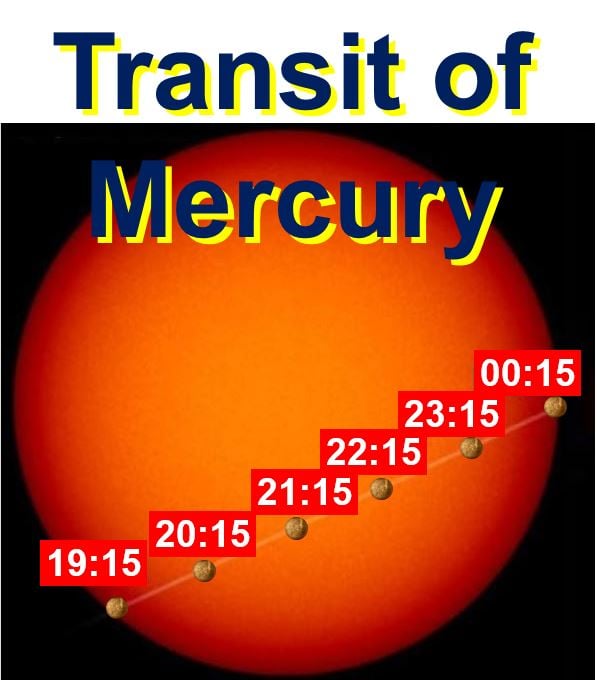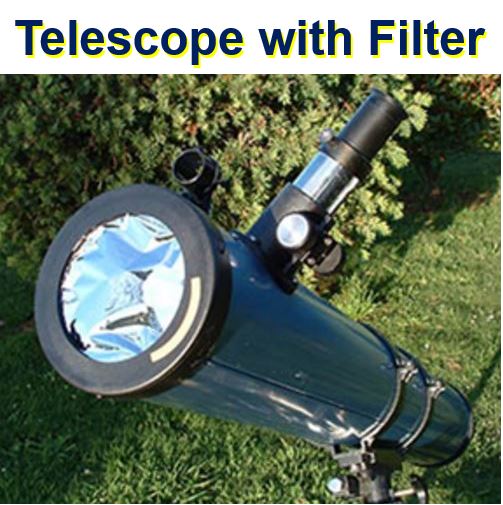When you watch the transit of Mercury on 9th May – next Monday – make sure your equipment is fitted with special, approved filters so that your eyes are protected, says the Royal Astronomical Society. Looking straight at the Sun without protection can severely and permanently damage your eyesight.
According to the Royal Astronomical Society:
“Looking directly at the Sun, either during the transit or at any other time, can cause permanent damage to the retina, leading to loss of vision or blindness.”
What is the transit of mercury? This occurs when Mercury – the Solar System’s smallest planet and the closest one to the Sun – passes directly between the Sun and the Earth.
 This was the path of Mercury during the transit ten years ago (2006). The planet is too small to make any discernible difference to the amount of daylight that hits the Earth’s surface. (Image: mercury.ras.ac.uk)
This was the path of Mercury during the transit ten years ago (2006). The planet is too small to make any discernible difference to the amount of daylight that hits the Earth’s surface. (Image: mercury.ras.ac.uk)
Mercury does not block out the Sun
However, it is not like a lunar eclipse when the Moon blocks the Sun completely and everything goes dark. Mercury is a tiny planet, much further from Earth than the Moon, and appears just as a tiny dot in front of a huge Sun. During the transit there is no discernible change in the amount of sunlight that hits the Earth.
If you live near central London, perhaps you should consider vising the Royal Astronomical Society’s courtyard at Burlington House, Piccadilly, where members of the public have been invited to enjoy the transit of Mercury using specially set-up telescopes and astronomical equipment.
The transit of Mercury – a relatively rare event
There are only from thirteen to fourteen transits each century, with the last one occurring in 2006 – the last such event in Britain was in 2003.
After this year’s transit of Mercury on 9th May, the next two will take place in 2019 and 2032.
According to the Royal Astronomical Society (RAS), we should all have a good view of the transit in the UK next week, that is, as long as there are clear skies.
 The Royal Astronomical Society Says: “If you already have a telescope you must ensure you have a good quality filter over the telescope’s objective, or in a reflector, the open end of the tube. This must be obtained from a reputable astronomical supplier and meet the relevant safety standards. You should never use the filter at the eyepiece end as it may crack or melt in the concentrated heat.” (Image: mercury.ras.ac.uk)
The Royal Astronomical Society Says: “If you already have a telescope you must ensure you have a good quality filter over the telescope’s objective, or in a reflector, the open end of the tube. This must be obtained from a reputable astronomical supplier and meet the relevant safety standards. You should never use the filter at the eyepiece end as it may crack or melt in the concentrated heat.” (Image: mercury.ras.ac.uk)
The event will start at 12:12 BST and end at 19:42 BST. Observers will see a silhouetted disk – Mercury – gradually making its way across a bright solar surface.
Regarding how much of the Sun is blocked, the RAS says:
“Because the planet is so small, it only blocks out a tiny part of the light of the Sun. This means it is impossible to see Mercury, and dangerous to try to observe it with the unaided eye, or using a telescope or binoculars without approved specially designed filters.”
RAS holding an event in London
So that we can enjoy the transit of Mercury in safety, the RAS has organised a special event in the courtyard of Burlington House, Piccadilly, London W1J 0BQ.
A team of astrophysicists and astronomers will be on hand to help operate the telescopes – they have all been fitted with safe solar filters to protect viewers’ eyes.
The RAS is urging members of the public to come on 9th May, where its staff will be there to help from midday until the Sun sets over neighbouring buildings.
All the equipment, including a range of telescopes, will be mounted outside the Royal Academy.
A live feed of the transit of Mercury will also be hosted at the RAS’ lecture theatre. There will be a special mini-exhibition of Mercury materials in its library. “Both of these rooms are located in our building on the opposite side of the courtyard to the telescopes,” the RAS added.
Satellites to see #Mercury enter spotlight on May 9 https://t.co/AjdTzzXJVQ cc: @spaceweather @PlanetarioMad pic.twitter.com/HMXrffBjJH
— Massimo (@Rainmaker1973) 3 May 2016
Prof. Martin Barstow, President of the RAS, Pro Vice Chancellor and Head of the College of Science and Engineering at the University of Leicester, said:
“It is always exciting to see rare astronomical phenomena, such as this transit of Mercury. They show that astronomy is a science that is accessible to everyone, and I would encourage you to take a look if the weather is clear… but do follow the safety advice!”
People in Western Europe, the eastern part of North America, most of South America, West Africa and northwest Africa will be able to see the transit of Mercury on 9th May.
The RAS said:
“Most of the transit (either ending with sunset or starting at sunrise) will be visible from the rest of North and South America, the eastern half of the Pacific, the rest of Africa and most of Asia. Observers in eastern Asia, south-eastern Asia and Australasia will not be able to see the transit.”
 In 1631, French astronomer Pierre Gassendi (above) saw the Transit of Mercury, making him the first human ever to see the event. (Image: Wikipedia)
In 1631, French astronomer Pierre Gassendi (above) saw the Transit of Mercury, making him the first human ever to see the event. (Image: Wikipedia)
Although the transits of Mercury are fairly rare events, when they do occur they are observable from several parts of the world.
The event was first witnessed by Pierre Gassendi (1592-1655), a French scientist, astronomer, philosopher, priest and mathematician in 1631, about twenty years after the invention of the telescope.
Louis Mayo, program manager at NASA’s Goddard Space Flight Center in Greenbelt, Maryland, USA, said:
“Back in 1631, astronomers were only doing visual observations on very small telescopes by today’s standards.”
Since those days, technology has advanced considerably. Today we can study the Sun and planetary transits in much greater detail.
The National Aeronautics and Space Administration (NASA) says:
“[The transit of Mercury] is the passage of a planet across the Sun’s bright disk. At this time, the planet can be seen as a small black disk slowly moving in front of the Sun. The orbits of Mercury and Venus lie inside Earth’s orbit, so they are the only planets which can pass between Earth and Sun to produce a transit.”
 Solar Projection: this method was said to be a safe way to view the Sun before solar filter came along – today it is regarded as less safe. However, if you do it right, there is no danger. The idea is to use your telescope without filters, but to project the Sun’s image onto a screen. (Image: twitter.com/cosmos4u)
Solar Projection: this method was said to be a safe way to view the Sun before solar filter came along – today it is regarded as less safe. However, if you do it right, there is no danger. The idea is to use your telescope without filters, but to project the Sun’s image onto a screen. (Image: twitter.com/cosmos4u)
Why is the planet called Mercury?
Mercury was the Roman messenger of the gods. The Romans believed that the gods and goddesses controlled everything.
The messenger Mercury had wings on his helmet and shoes, and travelled ultra-rapidly from place to place.
The planet Mercury is also a fast mover, orbiting the Sun at very high speed. According to NASA, that is why the small planet is called Mercury.
Earth orbits the Sun in 365 days, compared to Mercury’s 88 days.
Mercury’s transits very useful for astronomers in the past
Although there is no scientific reason for observing the transit of Mercury today, many years ago they did help astronomers to work out the distance from the Earth to the Sun.
By observing the transit from two different places on our planet’s surface, it was possible to estimate the distance of Mercury. Then, because the length of each planet’s year is associated to its distance from the Sun, knowing Mercury’s distance gave Earth’s distance from the Sun, as well as those of all the other planets.
Regarding taking photographs of the event, the Society for Popular Astronomy says:
“Taking photos through a telescope is quite tricky without the right equipment, so you might have to settle for taking snaps of the projected image or holding your camera up to the eyepiece and hoping for the best.”
“The clever way to do it is to have an adapter that allows you to link to the telescope a camera whose lens you can remove, so you are using it as a big telephoto lens. Cheaper telescopes may not work with adapters, however, so check with your telescope supplier before buying the adapter for your particular camera.”
Video – How to view the Transit of Mercury
Lucy Green, from the Society for Popular Astronomy, talks about what will happen on 9th May when Mercury transits the face of the Sun, and how to observe it safely.
